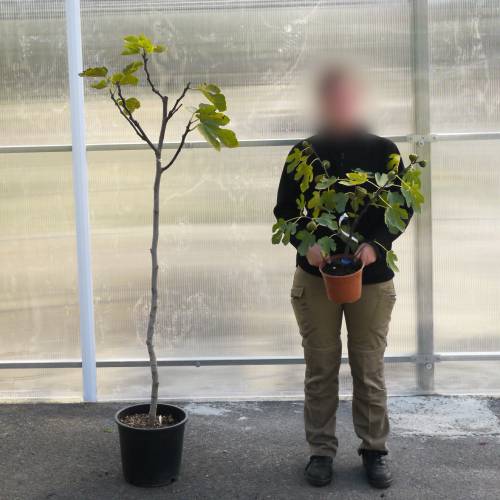
Plants
Fig Tree 'Brown Turkey' / Ficus carica Brown Turkey
-
61.88 € Fig tree 'Brown Turkey'
7590T - Available
-
59.23 € Fig tree 'Brown Turkey'
7590U - Available
-
8.84 € Fig tree 'Brown Turkey'
7590Y - Available
-
8.27 € Fig tree 'Brown Turkey'
7590Z - Available
-
7.75 € Fig tree 'Brown Turkey'
7590I - Available
-
7.23 € Fig tree 'Brown Turkey'
7590M - Available
-
6.71 € Fig tree 'Brown Turkey'
7590W - Available
-
6.19 € Fig tree 'Brown Turkey'
7590N - Available
-
5.75 € Special Offer - 20%
7590M1 - Available
-
5.67 € Fig tree 'Brown Turkey'
7590X - Available
-
5.15 € Fig tree 'Brown Turkey'
7590x - Available
-
0.40 € FERTILISER
7590A - Available
-
Geographical origins: Persia and Asia Minor.
Adult sizes: Height up 5 m, spread up to 4 m.
Foliage: Deciduous.
Type of soil: Any, preferably well drained.
Climate: Hardy to -15°C.
Site: Full sun, sheltered from wind.
Characteristics and uses:
The Fig tree 'Brown Turkey' is a beautiful ornamental tree. It will also provide you with some cooling shade in the summer. It produces figs' flowers in summer and figs in the autumn. Its caramel-coloured fruits are really sweet. They are best eaten fresh or in jams.
The Fig tree 'Brown Turkey' is one of the most cold- resistant' variety and therefore is highly recommended in cold winters 'areas providing it is planted sheltered from cold wind and in a free-draining soil.
Plant them now: the shortest way to your plate is through your garden!
Caution: The sap of the fig tree becomes toxic under the influence of the sun and the skin's perspiration: it can provoke allergies or skin' reactions which can go as far as burns. Make sure to protect your skin while pruning or handling the branches by wearing gloves and ensure that your children do not play with the leaves!
Jean-Michel Groult advises you
Sensitive to the cold by nature
The fig tree, once well established, withstands frost up to -12°C approximately, but it is not totally hardy. A harsh cold makes it regrow from the stump which needs to be sheltered against a wall to ensure that the tree will grow again, with the least possible damage, in the spring. In this way, protected against a south-exposed wall, it is possible to harvest figs everywhere in France. The choice of the variety is important, as to get fruits in colder areas, you must choose a variety known as ‘unifère’( it only produces one flush of fruits per year) and early. The variety ‘Ronde de Bordeaux’ is the best in that case. If you only grow a Fig tree for its decorative aspect, it is of course a different matter. In areas where winter temperatures do not go below -8°C and at altitudes below 500 m, all varieties can be grown without needing protection.
Does it need pruning?
It is not necessary to prune a Fig tree in order to get harvests, unlike the classic fruiting species (apples, pears…) but it not forbidden to do so, if for example, it does take out too much space or if it takes on a shape which does not pleases you. Here are the possible pruning’s that can be done on Fig trees:
- To grow it as a tree: let the main trunk grow upright and cut right back all the growths which grow from the base.
- To grow it as a shrub: let 3 to 5 growths from the base (in this case select a young specimen and not a young tree which already has a main stem). Cut out all the other shootings.
- To limit its height: pollard the stems 50 cm below the maximum wished- size, always at the axil of a branch (never in the middle of a non-branched one).
- To limit its spread: shorten the side stems, cutting them at the axil of a branch you want to keep.
Creative Fig trees
The Fig tree is a tree which happily lends itself to the shape you want to give it. For example, you can train the branches against a wall as if it was a climbing rose. In this way, it benefits from the wall’s warmth and is sheltered from cold wind. The Fig tree can also be trained like Blackberry bushes, as a tray-shape. You need a Fig tree which has a single, high enough trunk. Spread out 4 branches horizontally in a cross-shape, training them on thick wires stretched out between stakes. Then cut the branches so as to only keep the ones which form an umbrella shape.

















